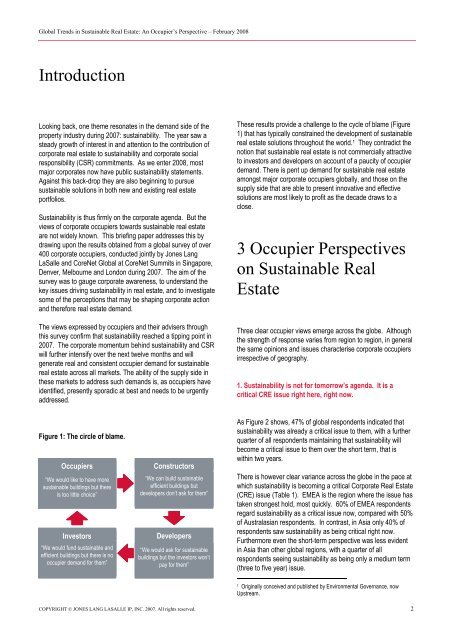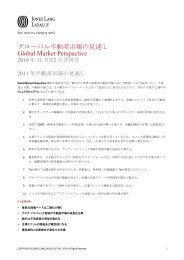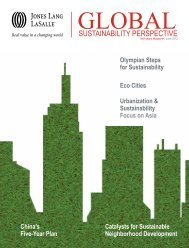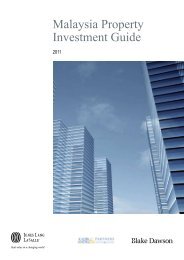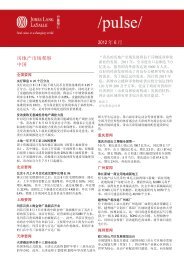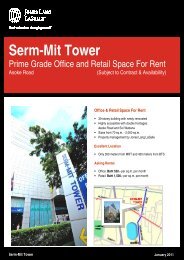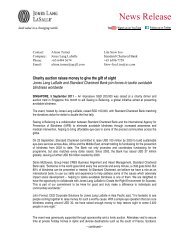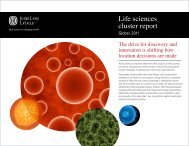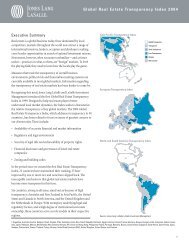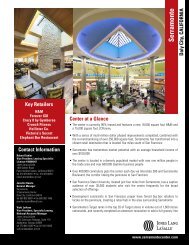Global Trends in Sustainable Real Estate - Jones Lang LaSalle
Global Trends in Sustainable Real Estate - Jones Lang LaSalle
Global Trends in Sustainable Real Estate - Jones Lang LaSalle
Create successful ePaper yourself
Turn your PDF publications into a flip-book with our unique Google optimized e-Paper software.
<strong>Global</strong> <strong>Trends</strong> <strong>in</strong> Susta<strong>in</strong>able <strong>Real</strong> <strong>Estate</strong>: An Occupier’s Perspective – February 2008<br />
Introduction<br />
Look<strong>in</strong>g back, one theme resonates <strong>in</strong> the demand side of the<br />
property <strong>in</strong>dustry dur<strong>in</strong>g 2007: susta<strong>in</strong>ability. The year saw a<br />
steady growth of <strong>in</strong>terest <strong>in</strong> and attention to the contribution of<br />
corporate real estate to susta<strong>in</strong>ability and corporate social<br />
responsibility (CSR) commitments. As we enter 2008, most<br />
major corporates now have public susta<strong>in</strong>ability statements.<br />
Aga<strong>in</strong>st this back-drop they are also beg<strong>in</strong>n<strong>in</strong>g to pursue<br />
susta<strong>in</strong>able solutions <strong>in</strong> both new and exist<strong>in</strong>g real estate<br />
portfolios.<br />
Susta<strong>in</strong>ability is thus firmly on the corporate agenda. But the<br />
views of corporate occupiers towards susta<strong>in</strong>able real estate<br />
are not widely known. This brief<strong>in</strong>g paper addresses this by<br />
draw<strong>in</strong>g upon the results obta<strong>in</strong>ed from a global survey of over<br />
400 corporate occupiers, conducted jo<strong>in</strong>tly by <strong>Jones</strong> <strong>Lang</strong><br />
<strong>LaSalle</strong> and CoreNet <strong>Global</strong> at CoreNet Summits <strong>in</strong> S<strong>in</strong>gapore,<br />
Denver, Melbourne and London dur<strong>in</strong>g 2007. The aim of the<br />
survey was to gauge corporate awareness, to understand the<br />
key issues driv<strong>in</strong>g susta<strong>in</strong>ability <strong>in</strong> real estate, and to <strong>in</strong>vestigate<br />
some of the perceptions that may be shap<strong>in</strong>g corporate action<br />
and therefore real estate demand.<br />
The views expressed by occupiers and their advisers through<br />
this survey confirm that susta<strong>in</strong>ability reached a tipp<strong>in</strong>g po<strong>in</strong>t <strong>in</strong><br />
2007. The corporate momentum beh<strong>in</strong>d susta<strong>in</strong>ability and CSR<br />
will further <strong>in</strong>tensify over the next twelve months and will<br />
generate real and consistent occupier demand for susta<strong>in</strong>able<br />
real estate across all markets. The ability of the supply side <strong>in</strong><br />
these markets to address such demands is, as occupiers have<br />
identified, presently sporadic at best and needs to be urgently<br />
addressed.<br />
Figure 1: The circle of blame.<br />
Occupiers<br />
“We would like to have more<br />
susta<strong>in</strong>able build<strong>in</strong>gs but there<br />
is too little choice”<br />
Investors<br />
“We would fund susta<strong>in</strong>able and<br />
efficient build<strong>in</strong>gs but there is no<br />
occupier demand for them”<br />
Constructors<br />
“We can build susta<strong>in</strong>able<br />
efficient build<strong>in</strong>gs but<br />
developers don’t ask for them”<br />
Developers<br />
“We would ask for susta<strong>in</strong>able<br />
build<strong>in</strong>gs but the <strong>in</strong>vestors won’t<br />
pay for them”<br />
These results provide a challenge to the cycle of blame (Figure<br />
1) that has typically constra<strong>in</strong>ed the development of susta<strong>in</strong>able<br />
real estate solutions throughout the world. 1 They contradict the<br />
notion that susta<strong>in</strong>able real estate is not commercially attractive<br />
to <strong>in</strong>vestors and developers on account of a paucity of occupier<br />
demand. There is pent up demand for susta<strong>in</strong>able real estate<br />
amongst major corporate occupiers globally, and those on the<br />
supply side that are able to present <strong>in</strong>novative and effective<br />
solutions are most likely to profit as the decade draws to a<br />
close.<br />
3 Occupier Perspectives<br />
on Susta<strong>in</strong>able <strong>Real</strong><br />
<strong>Estate</strong><br />
Three clear occupier views emerge across the globe. Although<br />
the strength of response varies from region to region, <strong>in</strong> general<br />
the same op<strong>in</strong>ions and issues characterise corporate occupiers<br />
irrespective of geography.<br />
1. Susta<strong>in</strong>ability is not for tomorrow’s agenda. It is a<br />
critical CRE issue right here, right now.<br />
As Figure 2 shows, 47% of global respondents <strong>in</strong>dicated that<br />
susta<strong>in</strong>ability was already a critical issue to them, with a further<br />
quarter of all respondents ma<strong>in</strong>ta<strong>in</strong><strong>in</strong>g that susta<strong>in</strong>ability will<br />
become a critical issue to them over the short term, that is<br />
with<strong>in</strong> two years.<br />
There is however clear variance across the globe <strong>in</strong> the pace at<br />
which susta<strong>in</strong>ability is becom<strong>in</strong>g a critical Corporate <strong>Real</strong> <strong>Estate</strong><br />
(CRE) issue (Table 1). EMEA is the region where the issue has<br />
taken strongest hold, most quickly. 60% of EMEA respondents<br />
regard susta<strong>in</strong>ability as a critical issue now, compared with 50%<br />
of Australasian respondents. In contrast, <strong>in</strong> Asia only 40% of<br />
respondents saw susta<strong>in</strong>ability as be<strong>in</strong>g critical right now.<br />
Furthermore even the short-term perspective was less evident<br />
<strong>in</strong> Asia than other global regions, with a quarter of all<br />
respondents see<strong>in</strong>g susta<strong>in</strong>ability as be<strong>in</strong>g only a medium term<br />
(three to five year) issue.<br />
1 Orig<strong>in</strong>ally conceived and published by Environmental Governance, now<br />
Upstream.<br />
COPYRIGHT © JONES LANG LASALLE IP, INC. 2007. All rights reserved. 2


